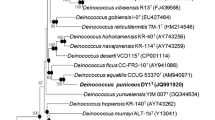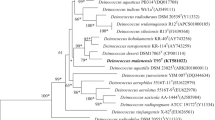Abstract
A Gram-negative, non-motile, short rod-shaped bacterial strain, designated N5T, was isolated from a rice field soil in South Korea. Phylogenetic analysis based on the 16S rRNA gene sequence of the new isolate showed that strain N5T belongs to the genus Deinococcus, family Deinococcaceae, showing the highest sequence similarity to Deinococcus grandis KACC 11979T (98.4 %) and Deinococcus daejeonensis KCTC 13751T (97.5 %). Strain N5T exhibits resistance to gamma-radiation similar to that of other members of the genus Deinococcus, with a D10 value in excess of 4 kGy. Chemotaxonomic data showed that the most abundant fatty acids are C16:1 ω7c (25.25 %), C15:1 ω6c (19.77 %), C17:1 ω6c (11.87 %), and C17:0 (9.41 %), and the major polar lipid is an unknown phosphoglycolipid. The predominant respiratory quinone is menaquinone MK-8. The DNA G+C content is 71.4 mol%. Phenotypic, phylogenetic, and chemotaxonomic data support designation of strain N5T as a novel species of the genus Deinococcus, for which the name Deinococcus soli sp. nov. is proposed. The type strain is N5T (=KCTC 33153T = JCM 19176T).


Similar content being viewed by others
References
Brooks BW, Murray RGE (1981) Nomenclature for “Micrococcus radiodurans” and other radiation-resistant cocci: Deinococcaceae fam. nov. and Deinococcus gen. nov., including five species. Int J Syst Evol Microbiol 31(3):353–360
Buck JD (1982) Nonstaining (KOH) method for determination of Gram reactions of marine bacteria. Appl Environ Microbiol 44:992–993
Collins MD, Jones D (1981) Distribution of isoprenoid quinone structural types in bacteria and their taxonomic implication. Microbiol Rev 45(2):316–354
Daly MJ, Gaidamakova EK, Matrosova VY, Vasilenko A, Zhai M, Venkateswaran A, Hess M, Omelchenko MV, Kostandarithes HM, Makarova KS, Wackett LP, Fredrickson JK, Ghosal D (2004) Accumulation of Mn(II) in Deinococcus radiodurans facilitates gamma-radiation resistance. Science 306(5698):1025–1028. doi:10.1126/science.1103185
Ezaki T, Hashimoto Y, Yabuuchi E (1989) Fluorometric deoxyribonucleic acid-deoxyribonucleic acid hybridization in microdilution wells as an alternative to membrane filter hybridization in which radioisotopes are used to determine genetic relatedness among bacterial strains. Int J Syst Evol Microbiol 39:224–229
Felsenstein J (1985) Confidence limits on phylogenies: an approach using the bootstrap. Evolution 39:783–791
Fitch WM (1971) Toward defining the course of evolution: minimum change for a specified tree topology. Syst Zool 20(4):406–416
Hiraishi A, Ueda Y, Ishihara J, Mori T (1996) Comparative lipoquinone analysis of influent sewage and activated sludge by high performance liquid chromatography and photodiode array detection. J Gen Appl Microbiol 42:457–469
Hirsch P, Gallikowski CA, Siebert J, Peissl K, Kroppenstedt R, Schumann P, Stackebrandt E, Anderson R (2004) Deinococcus frigens sp. nov., Deinococcus saxicola sp. nov., and Deinococcus marmoris sp. nov., low temperature and draught-tolerating, UV-resistant bacteria from continental Antarctica. Syst Appl Microbiol 27(6):636–645. doi:10.1078/0723202042370008
Im WT, Jung HM, Ten LN, Kim MK, Bora N, Goodfellow M, Lim S, Jung J, Lee ST (2008) Deinococcus aquaticus sp. nov., isolated from fresh water, and Deinococcus caeni sp. nov., isolated from activated sludge. Int J Syst Evol Microbiol 58:2348–2353. doi:10.1099/ijs.0.64082-0
Kämpfer P, Lodders N, Huber B, Falsen E, Busse HJ (2008) Deinococcus aquatilis sp. nov., isolated from water. Int J Syst Evol Microbiol 58:2803–2806. doi:10.1099/ijs.0.2008/001206-0
Kim OS, Cho YJ, Lee K, Yoon SH, Kim M, Na H, Park SC, Jeon YS, Lee JH, Yi H, Won S, Chun J (2012) Introducing EzTaxon-e: a prokaryotic 16S rRNA gene sequence database with phylotypes that represent uncultured species. Int J Syst Evol Microbiol 62:716–721. doi:10.1099/ijs.0.038075-0
Kimura M (1980) A simple method for estimating evolutionary rates of base substitutions through comparative studies of nucleotide sequences. J Mol Evol 16(2):111–120
Komagata K, Suzuki KI (1987) Lipid and cell-wall analysis in bacterial systematics. Methods Microbiol 19:161–205
Kuykendall LD, Roy MA, O’Neill JJ, Devine TE (1988) Fatty acids, antibiotic resistance and deoxyribonucleic acid homology groups of Bradyrhizobium japonicum. Int J Syst Evol Microbiol 38:358–361. doi:10.1099/00207713-38-4-358
Lai WA, Kämpfer P, Arun AB, Shen FT, Huber B, Rekha PD, Young CC (2006) Deinococcus ficus sp. nov., isolated from the rhizosphere of Ficus religiosa L. Int J Syst Evol Microbiol 56:787–791. doi:10.1099/ijs.0.64007-0
Minnikin DE, O’Donnell AG, Goodfellow M, Alderson G, Athalye M, Schaal A, Parlett JH (1984) An integrated procedure for the extraction of bacterial isoprenoid quinones and polar lipids. J Microbiol Methods 2(5):233–241. doi:10.1016/0167-7012(84)90018-6
Rainey FA, Nobre MF, Schumann P, Stackebrandt E, da Costa MS (1997) Phylogenetic diversity of the Deinococci as determined by 16S ribosomal DNA sequence comparison. Int J Syst Evol Microbiol 47(2):510–514
Rainey FA, Ray K, Ferreira M, Gatz BZ, Nobre MF, Bagaley D, Rash BA, Park MJ, Earl AM, Shank NC, Small AM, Henk MC, Battista JR, Kämpfer P, da Costa MS (2005) Extensive diversity of ionizing-radiation-resistant bacteria recovered from Sonoran Desert soil and description of nine new species of the genus Deinococcus obtained from a single soil sample. Appl Environ Microbiol 71(9):5225–5235. doi:10.1128/AEM.71.9.5225-5235.2005
Saitou N, Nei M (1987) The neighbor-joining method: a new method for reconstructing phylogenetic trees. Mol Biol Evol 4(4):406–425
Srinivasan S, Kim MK, Lim S, Joe M, Lee M (2012) Deinococcus daejeonensis sp. nov., isolated from sludge in a sewage disposal plant. Int J Syst Evol Microbiol 62:1265–1270. doi:10.1099/ijs.0.033316-0
Srinivasan S, Lee JJ, Lim S, Joe M, Kim MK (2012) Deinococcus humi sp. nov., isolated from soil. Int J Syst Evol Microbiol 62:2844–2850. doi:10.1099/ijs.0.037234-0
Stackebrandt E, Goebel BM (1994) Taxonomic note: a place for DNA–DNA reassociation and 16S rRNA sequence analysis in the present species definition in bacteriology. Int J Syst Evol Microbiol 44:846–849. doi:10.1099/00207713-44-4-846
Tamura K, Peterson D, Peterson N, Stecher G, Nei M, Kumar S (2011) MEGA5: molecular evolutionary genetics analysis using maximum likelihood, evolutionary distance, and maximum parsimony methods. Mol Biol Evol 28(10):2731–2739. doi:10.1093/molbev/msr121
Tamaoka J, Komagata K (1984) Determination of DNA base composition by reversed-phase high-performance liquid chromatography. FEMS Microbiol Lett 25:125–128
Thompson JD, Gibson TJ, Plewniak F, Jeanmougin F, Higgins DG (1997) The CLUSTAL_X windows interface: flexible strategies for multiple sequence alignment aided by quality analysis tools. Nucleic Acids Res 25(24):4876–4882. doi:10.1093/nar/25.24.4876
Wayne LG, Brenner DJ, Colwell RR, Grimont PAD, Kandler O, Krichevsky MI, Moore LH, Moore WEC, Murray RGE, Stackebrandt E, Starr MP, Trüper HG (1987) International committee on systematic bacteriology. Report of the ad hoc committee on reconciliation of approaches to bacterial systematics. Int J Syst Evol Microbiol 37:463–464
White O, Eisen JA, Heidelberg JF, Hickey EK, Peterson JD, Dodson RJ, Haft DH, Gwinn ML, Nelson WC, Richardson DL, Moffat KS, Qin H, Jiang L, Pamphile W, Crosby M, Shen M, Vamathevan JJ, Lam P, McDonald L, Utterback T, Zalewski C, Makarova KS, Aravind L, Daly MJ, Minton KW, Fleischmann RD, Ketchum KA, Nelson KE, Salzberg S, Smith HO, Venter JC, Fraser CM (1999) Genome sequence of the radioresistant bacterium Deinococcus radiodurans R1. Science 286(5444):1571–1577
Yoo SH, Weon HY, Kim SJ, Kim YS, Kim BY, Kwon SW (2010) Deinococcus aerolatus sp. nov. and Deinococcus aerophilus sp. nov., isolated from air samples. Int J Syst Evol Microbiol 60:1191–1195. doi:10.1099/ijs.0.016030-0
Acknowledgments
This work was supported by a special research grant from Seoul Women’s University (2014). We are grateful to Dr. Jean Euzéby for help with etymology, and to Dr. Sang-Yong Lim, and Mr. Min-Ho Joe in the Korea Atomic Energy Research Institute for their help with gamma-radiation-resistance testing.
Author information
Authors and Affiliations
Corresponding authors
Additional information
The NCBI GenBank/EMBL/DDBJ accession number for the 16S rRNA gene sequence of strain N5T (=KCTC 33153T=JCM 19176T) is KC771032.
Electronic supplementary material
Below is the link to the electronic supplementary material.
Rights and permissions
About this article
Cite this article
Cha, S., Srinivasan, S., Seo, T. et al. Deinococcus soli sp. nov., a Gamma-Radiation-Resistant Bacterium Isolated from Rice Field Soil. Curr Microbiol 68, 777–783 (2014). https://doi.org/10.1007/s00284-014-0542-7
Received:
Accepted:
Published:
Issue Date:
DOI: https://doi.org/10.1007/s00284-014-0542-7




